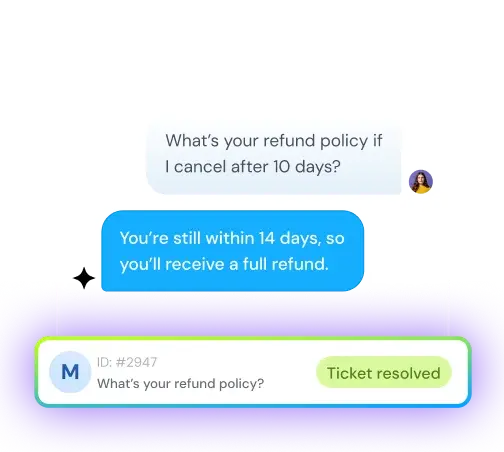Customer service automation explained: Process, tools & how it works
Sneha Arunachalam
Nov 21, 2025

Here’s a fact that should make any business pause: 80% of customers will leave after just one bad experience.
And with expectations rising faster than your team’s bandwidth, something has to bridge that gap.
That’s where customer service automation steps in.
It’s not about bots replacing humans, it’s about preventing those “bad experiences” before they happen. From a smart automated ticketing system that instantly tags, categorizes, and routes issues to support ticket automation that wipes out repetitive work, automation turns messy workflows into effortless service.
In this blog, we’ll break down how automated customer service actually works and how modern companies use it to deliver consistent, seamless support at scale.
Understanding customer service automation
Definition and scope of automated customer service
Let's break this down. Customer support automation software takes those routine support tasks and hands them over to technology instead of people. These systems field basic questions, point customers to helpful resources, and send the tricky stuff to your human agents.
We're talking way beyond simple chatbots here — think AI assistants, automated emails, phone systems that actually understand what people are saying, and self-help portals.
What modern automation tools include
Automation Type | Key Features | Primary Use Case |
AI-Powered Chatbots | Natural language understanding, sentiment analysis, multi-language support | Handling routine inquiries 24/7 |
Automated Ticketing System | Smart routing, priority assignment, workload balancing | Organizing and distributing support requests |
Knowledge Base Integration | Self-service portals, contextual article suggestions, search optimization | Empowering customers to solve their own issues |
Workflow Automation | Triggered actions, data synchronization, backend processing | Eliminating manual, repetitive tasks |
Email Response Automation | Template-based replies, smart categorization, follow-up scheduling | Managing high-volume email support |
Real-world example: Take Zappos, for instance. Their help desk automation system handles password resets, order tracking, and return status checks automatically. This frees up their legendary customer service team to focus on building relationships rather than answering "Where's my order?" for the hundredth time.
These systems never sleep, never take breaks, and handle tons of questions at once without you paying overtime. During busy seasons, a chatbot can tackle 200+ customer questions daily while your human agents max out around 35-50.
Difference between traditional and automated support

Think of it like this: traditional support is like having a small team working regular hours. Service desk automation is like having an army that never goes home.
Traditional vs automated Support: head-to-head comparison
Factor | Traditional Support | Automated Customer Service |
Availability | Business hours only (8-12 hours/day) | 24/7/365 without breaks |
Response Time | 5-15 minutes average wait | Instant (0 seconds) |
Volume Capacity | 35-50 tickets per agent daily | 200+ interactions per bot daily |
Operational Costs | High (salaries, benefits, overhead) | 30-40% lower than traditional |
Scalability | Requires hiring and training | Instant scaling without additional cost |
Customer Retention | 33% with single-channel approach | 89% with multi-channel automation |
Consistency | Varies by agent mood/experience | 100% consistent responses |
The differences hit you immediately. Your human team clocks out at 5 PM, but automated systems keep going all night. Nearly two-thirds of customers love chatbots specifically because they're always there.
Money-wise, automation can slash operational costs by up to 30% by handling all that repetitive stuff. Your human agents get to focus on problems that actually need empathy and creative thinking.
Speed? No contest. Automated response systems happen instantly, cutting wait times to basically zero. More than half of customers appreciate chatbots for this exact reason.
Role of AI and NLP in modern automation
AI and Natural Language Processing are what make modern customer experience automation actually work. These tools speed things up, make responses more personal, and run more efficiently.
How NLP powers smart automation
NLP Capability | What It Does | Business Impact |
Intent Recognition | Understands what customers really want | Routes requests accurately on first contact |
Sentiment Analysis | Detects frustration, anger, urgency | Prioritizes unhappy customers automatically |
Context Awareness | Remembers conversation history | Eliminates repetitive questions |
Multi-language Processing | Understands 100+ languages | Supports global customer base |
Entity Extraction | Identifies order numbers, dates, products | Speeds up issue resolution |
NLP lets automated workflow management systems understand what customers really mean, not just match keywords. Instead of forcing people through those awful phone menus, these systems let customers explain their problems naturally. No more "press 1 for billing, press 2 for technical support" nonsense.
The smart part? These systems get better on their own. They learn from every conversation, becoming more helpful without anyone updating code. They can even read between the lines to understand if someone's frustrated, angry, or just confused, then respond accordingly.
We're seeing something pretty remarkable happen. Nearly two-thirds of executives say generative AI is changing how they think about customer experience.
These advanced systems don't just answer questions — they make suggestions, offer personalized recommendations, and sometimes solve problems before customers even know they have them.
How customer service automation works
Customer service automation software isn't magic — it's a collection of smart technologies working together to handle your support load. Understanding how these pieces fit together helps you build something that actually makes customers happy.
Intent recognition using NLP
Think of intent recognition as your system's ability to read between the lines. When a customer says "I can't turn on my new device," the system doesn't just see words, it understands they need technical help.
Natural Language Processing (NLP) does the heavy lifting here. It scans customer messages for keywords, phrases, and even emotional cues. The system processes what someone types or says, then pulls out the important bits like "cancel subscription" or "update payment" to figure out what they're actually trying to do.
Common customer intents and how systems recognize them
Customer Message | Detected Intent | Automated Action |
"Where's my order #12345?" | Order tracking | Fetch shipping status, provide tracking link |
"I want my money back" | Refund request | Route to billing team, initiate refund workflow |
"This isn't working at all!" | Technical support + negative sentiment | Priority escalation to senior technical agent |
"Can I change my delivery address?" | Order modification | Access order system, verify change window, update details |
"How do I reset my password?" | Account access | Trigger automated password reset flow |
Real-world example: Spotify's support automation platform recognizes over 50 different user intents. When someone writes "my family plan isn't working," the system understands this could mean billing issues, access problems, or account settings — and asks one clarifying question before routing to the right solution path.
Here's where it gets smart. Advanced systems can tell the difference between "I want to book a flight" and "I have a question about my booking." Same topic, totally different needs. Machine learning algorithms sort these requests into the right categories, so each customer gets pointed in the right direction.
The real value? Context matters more than keywords. Your intelligent automation understands what people mean, not just what they say.
Automated ticket routing and escalation
Once your system knows what a customer needs, support ticket automation kicks in. Instead of someone manually sorting through tickets, the system handles it based on category, urgency, customer type, and other factors you set up.
How smart ticket management works

Here's how the automated ticketing system flows:
- Ticket comes in through any channel (email, chat, social media, phone)
- AI categorizes it using NLP and historical data
- System assigns priority based on your rules (SLA, customer tier, sentiment)
- Routes to the best-fit agent or team based on skills and availability
- Escalates automatically if deadlines get tight or customer frustration increases
Escalation triggers and actions
Trigger Type | When It Happens | Automated Action |
Time-Based | Ticket open for 24+ hours | Escalate to team lead, send apology email |
Sentiment-Based | Customer language shows anger | Immediate routing to experienced agent |
VIP Status | Enterprise/premium customer | Priority queue, senior agent assignment |
Multiple Contacts | Customer reaches out 3+ times | Manager review, expedited handling |
Complexity Score | AI detects multi-system issue | Route to technical specialist team |
Your automated help desk watches for trouble signs in real-time. Language like "still not working" or "urgent" triggers faster handling. This means frustrated customers get attention before they become former customers.
The practical wins are huge. Tickets land with the right people immediately, your team stays balanced workload-wise, and urgent stuff gets the priority it deserves.
Self-service portals and knowledge base integration
Self-service portals let customers solve their own problems without bothering your team. These hubs typically include searchable help content, account tools, and ticket tracking all in one place.
The knowledge base sits at the center, think of it as your always-on expert that never sleeps. Customers can search through FAQs, tutorials, and troubleshooting guides whenever they need help.
Essential components of effective self-service
Component | What It Includes | Customer Benefit |
Knowledge Base | Articles, FAQs, video tutorials | Find answers without waiting |
Account Management | Update profile, billing, preferences | Control their own information |
Ticket Portal | Submit, track, update requests | Visibility into support status |
Community Forum | User discussions, peer support | Learn from other customers |
Interactive Guides | Step-by-step walkthroughs | Visual problem-solving |
AI Search | Contextual article suggestions | Get relevant help faster |
Modern knowledge bases get smarter with AI integration. When connected to chatbots, they can suggest relevant articles based on what customers ask. As Intercom puts it, "AI chatbots armed with your knowledge base can scan your existing content with ease to support customers with intelligent self-service."
Step-by-step guide to automating customer service
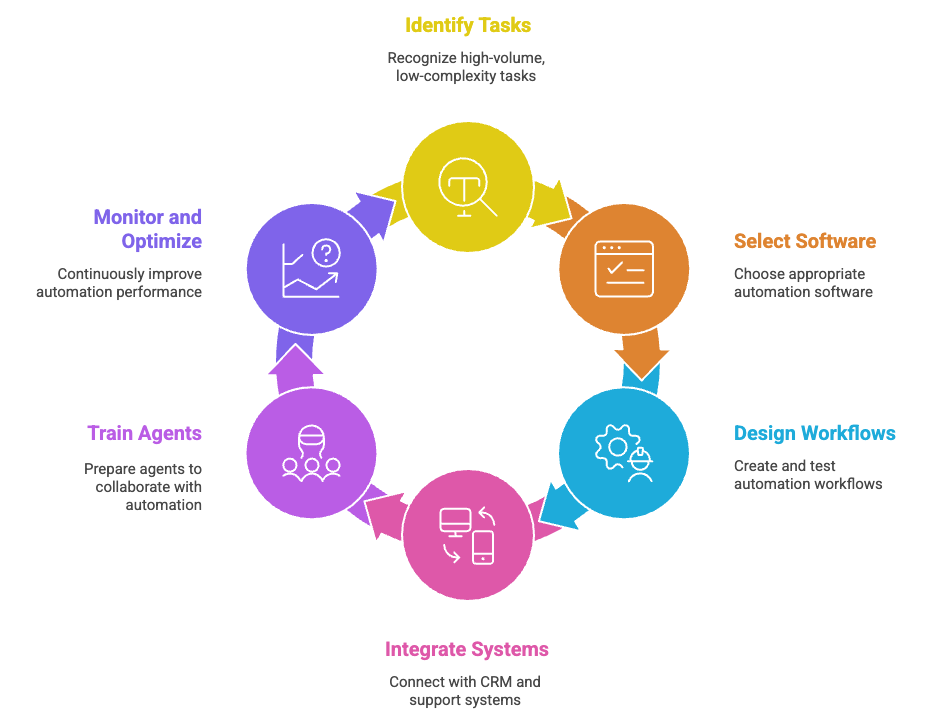
Automation isn't something you just flip on like a light switch. It takes a smart, step-by-step approach to get it right. Here are six steps that'll help you build automated systems that actually make your customers happy while giving your team some breathing room.
1. Identify high-volume, low-complexity tasks
Start with the obvious stuff. You know those repetitive tasks that make your team want to bang their heads against the wall? Those are your goldmine for automation.
Look for:
- Frequently asked questions and routine inquiries
- Data entry and updating tasks
- Order status checks and confirmations
- Password resets and account recovery requests
- Ticket categorization and routing
Map out these processes visually to better understand all critical connections between decision points, people, data, and systems. Tasks that follow fixed patterns with minimal variation make ideal automation candidates. Focus first on processes that frustrate your employees or customers—these are prime opportunities for automation.
2. Select the right customer service automation software
Here's where things get tricky. There are tons of options out there, and picking the wrong one can mess up your entire operation.
Think about your specific business needs first. What's your team size? How do you currently handle support? What channels do your customers use?
The big thing here is to make sure whatever you pick plays nice with your existing systems. Nobody wants their agents jumping between five different platforms just to help one customer.
Look for solutions offering customizable workflows that don't require technical expertise to modify.
Don't skip the security stuff either. Check their security measures, data encryption, and compliance with relevant regulations. Your automation solution should grow with you, not hold you back.
And if you’re looking for a platform that actually checks all those boxes, SparrowDesk is built for exactly this kind of flexibility. With enterprise-grade security, encryption, and AI-powered efficiency baked in, SparrowDesk grows with your business and keeps your support smooth, fast, and reliable as you scale.
Sign up and take a 14-day free trial to see SparrowDesk in action
14-day free trial • Cancel Anytime • No Credit Card Required • No Strings Attached
3. Design and test automation workflows
Before you roll this out to everyone, you need to map out exactly how things should work. Create a visual representation showing all steps, decision points, and possible paths.
Focus on three key elements: exceptional handling for unusual situations, handoffs between AI and human agents, and clear escalation paths.
Test your automated workflows thoroughly with a small group before wider deployment. Ask for feedback from stakeholders to ensure the process works as planned.
Don't just test it in a perfect lab environment. Simulate real-world conditions and get your key people involved in user acceptance testing. This builds buy-in from the start, which makes adoption way smoother.
4. Integrate with CRM and support systems
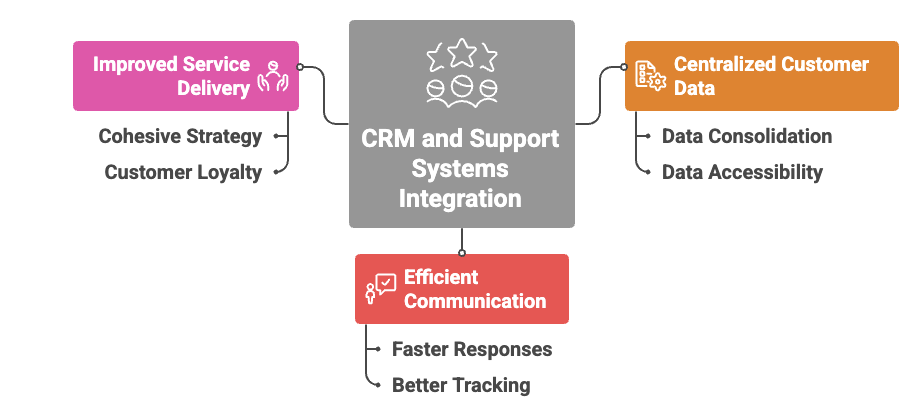
Think of this like connecting the dots between all your customer information. CRM integration bridges the gap between your customer data and third-party applications, allowing automated data synchronization.
When everything's connected properly, your automation can access the full customer story — past purchases, preferences, previous interactions. This lets your system tailor recommendations based on individual customer data.
Most modern systems use APIs to make different software talk to each other. Two-way integration ensures that changes made in either system reflect in the other, maintaining data consistency across platforms.
5. Train agents to work alongside automation
Here's something important — your human agents need different skills now. As AI handles the routine stuff, your people deal with the complex, nuanced problems that require real thinking. Traditional training doesn't cut it anymore since agents jump straight into challenging cases.
Train them on both the technical side of using automation tools and the critical thinking skills for complex problem-solving. They need to know when to trust what the system suggests and when their human judgment should override it.
Companies doing this right see better customer satisfaction scores and keep their agents longer. Plus, you can get new people up to speed faster while boosting their confidence.
6. Monitor and optimize continuously
Automation isn't a "set it and forget it" deal. You need to keep an eye on things and make adjustments. Measure improvements using metrics like response time reduction, employee experience enhancement, and cost savings.
Track key performance indicators including customer satisfaction scores, resolution rates, and deflection rates from human representatives. Use these insights to spot improvement opportunities and adjust your automation workflows.
Set up real-time monitoring so you catch problems early. Regular audits help maintain data quality and reveal optimization opportunities. Most importantly, collect feedback from both customers and support staff to keep improving.
Top 7 customer service automation tools for 2025
Let's be honest — picking the wrong automation tool can turn your customer service into a nightmare. We've tested dozens of options, and these seven actually deliver on their promises.
Comparison table: Top automation platforms
Platform | Best for | Starting price | Key strength | Automation coverage |
Sparrowdesk AI Agents | Growing teams | $16/agent/month | Smart automation | Upto 60% |
Zendesk AI Agents | Enterprise teams | $69/agent/month | Omnichannel consistency | Up to 80% |
Intercom Fin AI Copilot | SaaS companies | $39/user/month | Agent assistance | 70-75% |
Dashly | E-commerce businesses | $39/month | Conversion optimization | 65-70% |
Nextiva | Voice-heavy support | $25.95/user/month | Phone automation | 60-70% |
DevRev | Technical teams | Custom pricing | Developer-focused | 85% |
Freshdesk | Small to mid-size | $18/agent/month | Ease of use | 65-75 |
1. SparrowDesk AI Agents
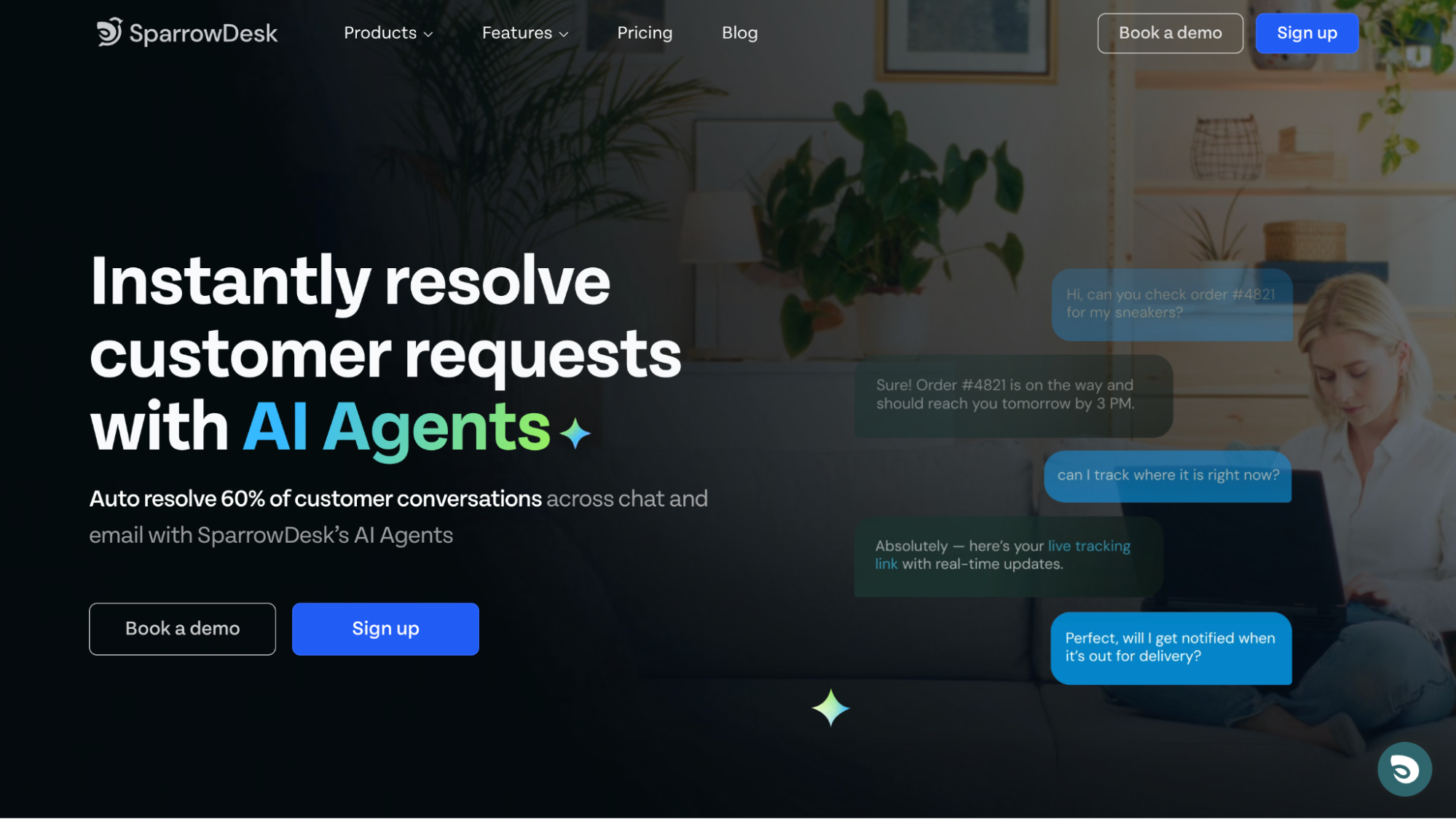
SparrowDesk’s AI Agents (powered by Luna) can instantly resolve up to 60% of customer tickets, giving your support team space to focus on more complex issues.
They’re available 24/7, delivering consistent, context-aware responses even when your team is offline.
What makes it special:
- Trains on anything — PDFs, help docs, past tickets, web content.
- Fully brandable — name, tone, avatar, persona.
- Gets smarter over time — learns from every interaction.
- Global-ready — multilingual, 24/7, seamless human escalation.
SparrowDesk AI pricing
- The AI Agent (Luna) is charged at $0.70 per resolution.
- AI Co-pilot (helps your agents) costs $16 per seat/month, billed annually.
- Base support plan pricing is:
- Starter: $16/seat/month
- Professional: $49/seat/month
- Enterprise: $89/seat/month
14-day free trial • Cancel Anytime • No Credit Card Required • No Strings Attached
2. Zendesk AI Agents
Think of Zendesk AI Agents like having a smart assistant that never sleeps. If you're already using Zendesk's ticketing system, this is a no-brainer. You get AI Agents Essential with any plan, but the Advanced version is where things get interesting — hybrid workflows, API integration, and analytics that actually make sense.
What makes it special:
- Multi-language support across 100+ languages
- Seamless handoff to human agents with full context
- Built-in quality scoring for every AI interaction
- Works across email, chat, social media, and phone
Here's what's cool: the platform speaks multiple languages and gets what customers really want, not just what they're saying. When things get complicated, it hands off to your human team seamlessly.
The numbers don't lie — Zendesk AI can handle up to 80% of interactions across all your channels. Plus, it checks its own work with built-in quality scoring for every interaction.
3. Intercom Fin AI Copilot
Picture this: every agent gets their own AI sidekick that knows everything about your business. That's Fin AI Copilot. It digs through help centers, past conversations, and internal docs to give agents exactly what they need.
What makes it special:
- Learns from your team's actual conversations
- Connects to Notion, Guru, Confluence, Google Docs
- Suggests responses in real-time during live chats
- Proactive outreach based on user behavior
What makes this different? It learns from your agents' actual conversations. Connect it to Notion, Guru, Confluence — whatever you use — and it becomes smarter.
4. Dashly Chatbot Platform
Dashly treats customer communication like a conversation, not a transaction. Their platform connects chatbots, pop-ups, emails, live chat, and social media into one smooth experience. It's built to turn website visitors into customers at every step.
What makes it special:
- Behavioral triggers based on user actions
- A/B testing for conversation flows
- Lead qualification and scoring
- Native integrations with popular tools
The interface is clean and elegant — users actually enjoy using it. For businesses that need serious communication power, Dashly includes native integrations and triggered messaging that just works.
5. Nextiva Virtual Assistants
Nextiva's Intelligent Virtual Agents work like your best employees — they're available 24/7 and handle routine stuff so your team can focus on what matters. These AI-powered assistants manage voice and chat inquiries while cutting down escalations and costs.
What makes it special:
- No-code setup and configuration
- Natural voice conversations (not robotic)
- Appointment scheduling with calendar sync
- Payment processing over phone
- Detailed call analytics and reporting
Here's the best part: no coding required. Set up IVAs to handle scheduling, reminders, and balance checks without breaking a sweat. When human help is needed, the handoff includes all the context your agents need.
6. DevRev AI-native Support Platform
DevRev calls their AI platform "Computer," and it really does feel like having a super-smart teammate. It pulls together all your business data — messy and clean — into one place that powers your entire support operation.
What makes it special:
- Built specifically for technical and developer support
- Connects support directly to product/engineering teams
- Automatic ticket-to-issue conversion for dev teams
- Sophisticated knowledge graph of product capabilities
This isn't just a question-answering tool. Computer creates tickets, updates records, and keeps your teams in sync automatically.
7. Freshdesk Workflow Automator
Freshdesk makes automation feel effortless. Their tools handle everything from smart ticket routing to workflow automation, while Freddy AI learns from your past tickets and suggests the right fields automatically.
What makes it special:
- Intuitive visual workflow builder
- Pre-built automation templates
- Time-based and event-based triggers
- Automatic SLA management
- Skills-based routing
Your team saves time through automatic ticket assignment based on source, skills, and workload. The system watches for ticket updates and triggers actions instantly, so agents never miss customer responses.
4 Key benefits of customer service automation
Let's talk about what automation actually gets you. These aren't just nice-to-have perks — they're game-changing advantages that can make your business way more competitive.
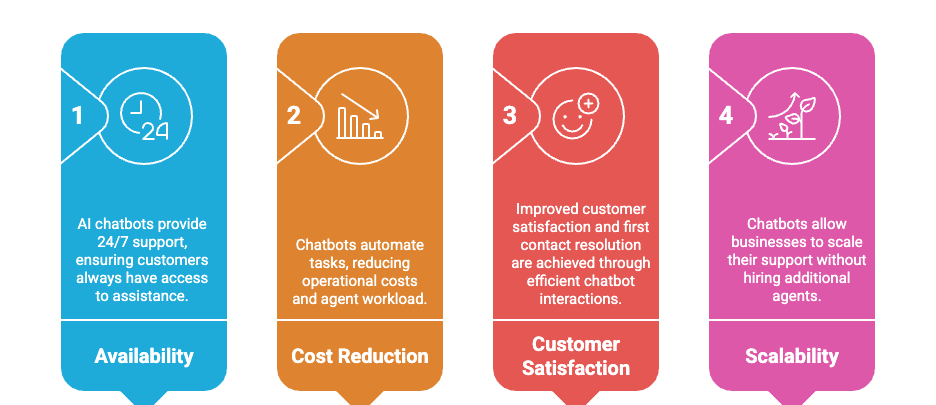
1. 24/7 availability and faster response times
Your automated systems don't sleep, take breaks, or call in sick. They handle customer questions at any hour without you paying overtime or managing shift schedules. No more customers waiting until Monday morning for answers to Friday afternoon problems.
Here's what's really impressive — automated responses can resolve tickets in zero seconds, which bumps up first response times by 37% overall. Your service stays consistent too. No bad days, no mood swings, just reliable help every single time.
2. Reduced operational costs and agent workload
Automation tackles the repetitive stuff so your human agents can focus on problems that actually need a human touch. The cost savings add up fast:
- Less manual work means fewer mistakes and less time wasted
- You save on training, labor, and infrastructure costs
- 67% of IT leaders say automation cuts manual task time in half
3. Improved CSAT and first contact resolution
Here's a neat fact — every percentage point improvement in first contact resolution bumps customer satisfaction up by 1%. When automation routes tickets to exactly the right place from the start, both your FCR and CSAT scores climb while your costs drop. Companies see CSAT improvements within just 30 days of implementing automation.
4. Scalability without hiring more agents
Think of automation like having an infinitely expandable team. When your support volume suddenly spikes 10x, your automated systems just handle it. No scrambling to hire temporary staff or asking everyone to work overtime.
Smart companies that blend AI with automation get 2.4 times better self-service rates than their competitors. That means fewer tickets hitting your human agents and more customers solving their own problems happily.
How to measure the success of automation
You can't improve what you don't measure. That's especially true with automation — without tracking the right numbers, you're basically flying blind.
Tracking CSAT, NPS, and resolution time
These three customer service metrics tell you everything you need to know about whether your automation actually works:
how fast you're solving problems.
Here's what good automation can do, AI-driven systems bump customer satisfaction up by 5-10%. Even better, companies using automated resolution cut their processing times by 99.7%. We're talking about going from 48 hours down to under 10 minutes.
Deflection rate from human agents
This number shows how many customer issues get solved without a human ever stepping in. Think of it as your automation's batting average.
The math looks like this: Self-service events × Success rate × Intent rate × No further action rate
So if you have: 400 × 80% × 60% × 40% = 76.8% deflection rate
The sweet spot? High deflection rate plus high customer satisfaction. That combo means your automation isn't just handling volume — it's actually solving problems.
Automation accuracy and escalation rate
Your escalation rate — that's tickets that need a human to jump in — should stay under 10%. Go higher than that, and your automation might be creating more problems than it solves.
Smart companies have pushed their automation from handling 25% of decisions to 70%. Financial services companies hit 90% accuracy with their AI systems. Regular check-ins help you spot trends and coach your team on what's working.
Customer feedback and abandonment points
Nobody likes being hung up on. Call abandonment rates under 5% are okay, but 2% or less is where you want to be.
AI can actually spot when customers are getting frustrated before they bail. Those language patterns are like early warning signals — catch them fast enough, and you can turn a bad experience around.
Here's the scary part: 42% of customers will stop buying after just two negative experiences. Real-time feedback helps you fix problems before they become deal-breakers.
Conclusion
Automation isn’t just a convenient upgrade anymore. It’s the dividing line between businesses that deliver and those that leave customers frustrated. Throughout this guide, you’ve seen the impact: automation cuts costs by 40%, resolves issues 52% faster, and keeps your support engine running effortlessly in the background. With a strong automated ticketing system in place, your team no longer drowns in repetitive tasks or unorganized queues — everything simply moves where it needs to, when it needs to.
But the real win? Your customers feel the difference instantly. No long waits. No painful back-and-forth. No getting lost between departments.
Smart support ticket automation ensures every issue is handled quickly, accurately, and consistently, while your human agents focus on the conversations that truly require empathy and expertise.
Good automation feels almost invisible — smooth, natural, and reliable — until suddenly you realize just how much more efficient everything has become.
And the only way to know it’s working is to track the numbers that matter: CSAT, deflection rates, resolution times. These metrics reveal whether your automation is improving the customer experience—not just reducing workload.
If you’re ready to see what thoughtful automation can do, SparrowDesk is where that transformation begins.
14-day free trial • Cancel Anytime • No Credit Card Required • No Strings Attached
The companies winning aren’t choosing between human warmth and intelligent systems, they’re blending both. And the way you approach automation today determines whether customer service becomes your competitive edge or simply another operational cost.
Quick summary: Automated customer service
Customer service automation offers transformative benefits for businesses ready to embrace AI-powered support solutions. Here are the essential insights for successful implementation:
✓ Start with high-volume, low-complexity tasks - Focus automation on repetitive inquiries like FAQs, password resets, and order status checks to maximize immediate impact and ROI.
✓ Automation delivers measurable results - Businesses report 40% cost reduction, 52% faster resolution times, and ability to handle 10x support volume without hiring additional agents.
✓ Choose tools that integrate seamlessly - Select customer support automation software that connects with existing CRM and support systems to prevent workflow disruptions and maintain data consistency.
✓ Measure success through key metrics - Track CSAT scores, deflection rates, and resolution times to ensure automation enhances rather than hinders customer experiences.
✓ Human agents remain essential - Intelligent automation works best alongside skilled staff who handle complex issues requiring empathy and critical thinking, not as their replacement.
The future belongs to companies that strategically blend human expertise with AI efficiency. By following the six-step implementation process and continuously optimizing based on performance data, businesses can transform customer service from a cost center into a competitive advantage that drives loyalty and growth.
Frequently Asked Questions
High-volume, low-complexity tasks are ideal for support ticket automation. These include handling frequently asked questions, password resets, order status checks, appointment scheduling, basic account management functions, ticket routing and categorization, and simple troubleshooting steps. Tasks with clear rules and predictable patterns automate most successfully.
Success can be measured by tracking key metrics such as Customer Satisfaction Score (CSAT) above 85%, Net Promoter Score (NPS) above 50, average resolution time reductions, deflection rate from human agents (target 70%+), automation accuracy rates, and escalation rates below 10%. Also monitor customer feedback and abandonment points to identify improvement areas.
When choosing customer service automation tools, businesses should consider integration capabilities with existing systems (CRM, e-commerce platforms), customizable workflows that don't require coding, security measures and compliance (GDPR, HIPAA), scalability to handle growth, multi-channel support (email, chat, social, phone), and the ability to handle your specific business needs.
Also evaluate vendor support, pricing structure, and implementation timeline.
No. The goal of customer support automation software is to augment, not replace, human agents. Automation handles repetitive, routine tasks (40-70% of volume), while human agents focus on complex issues requiring empathy, critical thinking, and creative problem-solving. The most successful companies use a hybrid model where AI and humans work together, each doing what they do best.
Common challenges include handling complex or emotional issues (solution: smart sentiment detection and easy escalation), integration with legacy systems (use middleware), maintaining human touch (leverage personalization through CRM data), keeping knowledge bases current (assign ownership and schedule regular reviews), and managing change resistance from staff (involve them early, provide training, show how automation helps them).
Implementation timelines vary based on complexity. Basic chatbot automation can be deployed in 2-4 weeks. Comprehensive automated workflow management systems with CRM integration typically take 2-3 months. Enterprise-wide implementations with legacy system integration may require 4-6 months. The key is phased rollout — start with one high-impact use case, measure results, then expand gradually.
